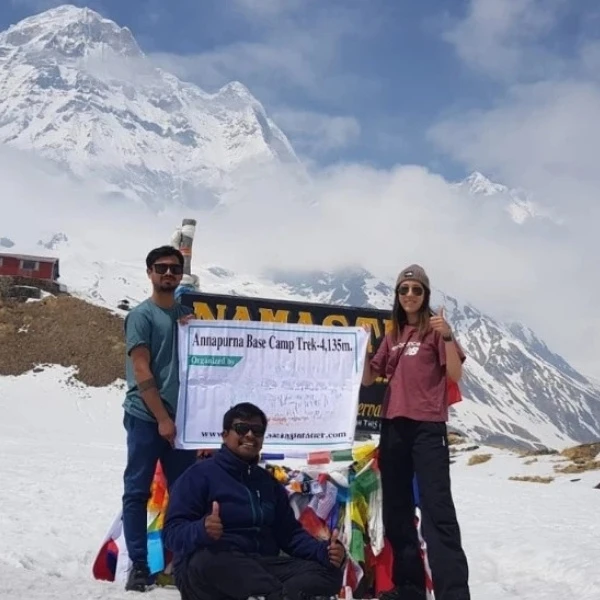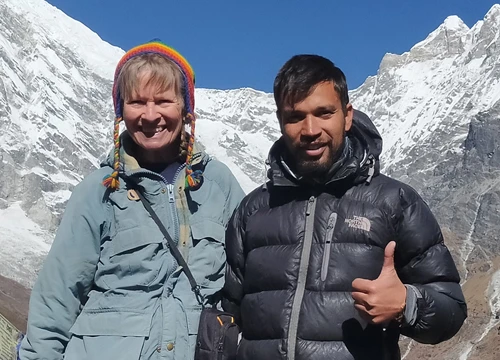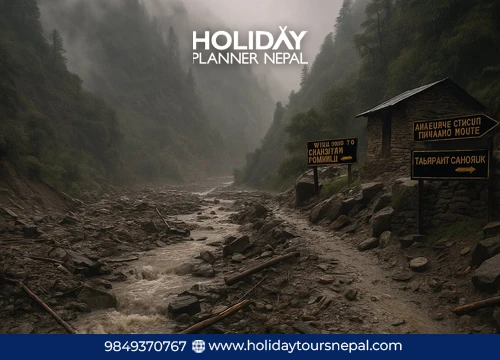Annapurna Base Camp Region during November
The Annapurna region, nestled in the heart of Nepal, is a trekker's paradise, offering a myriad of trails that cater to both novice and experienced hikers. The region is named after the majestic Annapurna massif, a collection of peaks that includes Annapurna I, Annapurna South, Gangapurna, and Machapuchare. These towering giants form a stunning backdrop to the diverse landscapes and rich cultural heritage that define the Annapurna region. From verdant subtropical forests to alpine meadows and high-altitude deserts, the terrain is as varied as it is beautiful.
The Annapurna region is also home to the Annapurna Conservation Area, the largest protected area in Nepal, which spans over 7,629 square kilometers. This conservation area is a haven for wildlife, including snow leopards, blue sheep, and a diverse array of bird species. The region's biodiversity is complemented by its cultural richness, with traditional Gurung and Magar villages dotting the landscape. These communities offer a glimpse into the traditional way of life in the Himalayas, with their unique customs, festivals, and warm hospitality.
Trekking in the Annapurna region is not only about the physical challenge but also about immersing oneself in the natural and cultural beauty of the area. The Annapurna Base Camp (ABC) trek is a favorite among trekkers, offering a perfect blend of stunning scenery, cultural experiences, and moderate difficulty. The journey to ABC takes you through terraced fields, rhododendron forests, and high-altitude landscapes, culminating in a breathtaking amphitheater of snow-capped peaks. November, with its clear skies and pleasant temperatures, is the ideal time to embark on this unforgettable adventure.
Why November is Ideal for Trekking?
November is arguably the best month for trekking in the Annapurna region, and for good reason. Firstly, the weather in November is near-perfect for hiking. The monsoon rains have subsided, leaving behind clear blue skies and lush green landscapes. The daytime temperatures are comfortably warm, averaging between 12°C and 18°C , while the nights are cool and can be excessively cold. Sometimes the snow can affect trekking conditions, but trekkers will be allowed to fully enjoy the snowcapped mountains with breathtaking scenery and the snowy trails can be.
Another significant advantage of trekking in November is the reduced risk of rain and landslides. The trails are dry and stable, which not only makes for safer trekking but also ensures that the stunning views of the Annapurna massif are unobstructed by clouds. The post-monsoon clarity means that you are treated to crisp, panoramic vistas of the snow-capped peaks, something that trekkers in other seasons might miss out on. The visibility is at its best, allowing you to capture those perfect photographs and create lasting memories.
Moreover, November is considered the shoulder season, which means that while the trails are popular, they are not as crowded as during the peak trekking months of April and May. This allows for a more serene and intimate trekking experience. You can fully immerse yourself in the tranquility of the Himalayas, enjoy the solitude of the trails, and have more meaningful interactions with fellow trekkers and locals. The combination of ideal weather, stunning views, and fewer crowds makes November the perfect time to embark on the Annapurna Base Camp Trek.
Weather Conditions of the Annapurna Trail in November
The weather in November is one of the primary reasons why this month is ideal for the Annapurna Base Camp Trek. After the monsoon season, the skies clear up, revealing the magnificent Himalayan peaks in all their glory. The average daytime temperatures in November range from 15°C to 20°C (59°F to 68°F), which is perfect for trekking. These mild temperatures mean that you can trek comfortably during the day without the need for heavy winter gear.
At higher altitudes, such as at Annapurna Base Camp itself, the temperatures can drop significantly, especially at night. However, even at these elevations, the nighttime temperatures in November are manageable, typically ranging from -2°C to 5°C (28°F to 41°F). With proper layering and preparation, you can stay warm and comfortable. It's important to note that November offers a relatively stable weather pattern, with minimal precipitation and clear skies making for excellent trekking conditions
Another advantage of trekking in November is the low humidity levels. The dry air makes it easier to breathe, especially at higher altitudes where the oxygen levels are lower. This is particularly beneficial for trekkers who are concerned about altitude sickness. The crisp and cool air invigorates you and adds an extra layer of enjoyment to the trekking experience. Overall, the favorable weather conditions in November contribute to an enjoyable and memorable trek to Annapurna Base Camp.
Breathtaking Scenery: Autumn Foliage and Views
One of the most enchanting aspects of trekking in November is the breathtaking scenery. As autumn sets in, the Annapurna region is transformed into a vibrant tapestry of colors. The forests and hillsides are adorned with golden hues as the leaves of the deciduous trees change color. The contrast between the fiery autumn foliage and the snow-capped peaks creates a stunning visual spectacle that is a treat for the eyes.
The clear skies in November offer unobstructed views of the Annapurna massif, including the iconic peaks of Annapurna I, Annapurna South, Hiunchuli, and Machapuchare. The panoramic vistas are truly awe-inspiring, with the towering mountains standing majestically against the deep blue sky. Each day of the trek brings new and captivating views, from the terraced fields and lush valleys to the high-altitude landscapes and glacial moraines. The beauty of the Annapurna region in November is unparalleled, making it a photographer's paradise.
In addition to the stunning mountain views, the trek also takes you through diverse landscapes, each with its own unique charm. The lower elevations are characterized by terraced fields and traditional villages, where you can witness the daily lives of the local people. As you ascend, the trail passes through dense rhododendron and bamboo forests, which are particularly enchanting in the autumn light. The higher altitudes offer a more rugged and dramatic landscape, with rocky paths, glacial rivers, and alpine meadows. The variety of scenery on the Annapurna Base Camp Trek in November ensures that there is always something new and beautiful to behold.
Cultural Experiences Along the Trail of Annapurna Base Camp
The Annapurna Base Camp Trek is not only a journey through stunning landscapes but also a cultural immersion into the heart of Nepal. The trail passes through several traditional Gurung and Magar villages, where you can experience the rich cultural heritage of the region. These communities have lived in the Himalayas for centuries, and their way of life is deeply intertwined with the natural environment. As you trek through these villages, you will have the opportunity to interact with the local people and learn about their customs, traditions, and daily lives.
One of the highlights of the cultural experience along the trek is the chance to stay in traditional teahouses. These family-run lodges offer basic but comfortable accommodations and are a great way to experience the local hospitality. The teahouses serve traditional Nepali meals, such as Dal Bhat (lentil soup with rice) and Momo (dumplings), which provide the sustenance needed for the trek. Sharing meals with fellow trekkers and locals in the cozy teahouse dining rooms creates a sense of camaraderie and connection that is a memorable part of the trekking experience.
In addition to the hospitality of the teahouses, you may also can witness local festivals and celebrations if you trek in November. The Dashain and Tihar festivals, which are two of the most important Hindu festivals in Nepal, often fall in November. These festivals are marked by elaborate rituals, vibrant decorations, and joyful celebrations. Participating in these cultural events provides a deeper understanding of the local way of life and adds a unique and enriching dimension to your trek. The cultural experiences along the Annapurna Base Camp Trek in November are as captivating as the natural beauty of the region.
Trekking Routes and Difficulty Levels of Annapurna Base Camp
The Annapurna Base Camp Trek offers a variety of routes, each with its own unique features and levels of difficulty. The most popular route is the classic Annapurna Base Camp trail, which typically takes 7 to 12 days to complete, depending on your starting point and pace. This route starts from either Nayapul or Ghandruk and passes through several picturesque villages, including Chhomrong, Bamboo, and Deurali, before reaching the base camp. The trail is well-marked and maintained, making it accessible to trekkers of all levels.
For those looking for a more challenging and extended trek, the Annapurna Circuit is an excellent option. This trek circumnavigates the entire Annapurna massif and takes approximately 15 to 20 days to complete. The Annapurna Circuit offers a diverse range of landscapes, from subtropical forests to high-altitude deserts, and includes the crossing of the Thorong La Pass at 5,416 meters (17,769 feet). While the Annapurna Circuit is more demanding than the base camp trek, it rewards trekkers with spectacular views and a sense of accomplishment.
Another option for trekkers is the Ghorepani Poon Hill Trek, which is a shorter and less strenuous alternative to the Annapurna Base Camp Trek. This trek can be completed in 4 to 5 days and offers panoramic views of the Annapurna and Dhaulagiri ranges from the vantage point of Poon Hill. The Ghorepani Poon Hill Trek is ideal for those with limited time or for beginners who want to experience the beauty of the Annapurna region without the demands of a longer trek. Regardless of the route you choose, trekking in the Annapurna region in November promises an unforgettable adventure.
Essential Packing List for Annapurna Base Camp for November Trekkers
Packing for the Annapurna Base Camp Trek in November requires careful consideration to ensure you are prepared for the varying weather conditions and altitudes. The key to a successful trek is layering, which allows you to adjust your clothing according to the temperature and activity level. Here is a comprehensive packing list to help you prepare for your trek:
Clothing:
- Base layers: moisture-wicking shirts and thermal underwear
- Insulating layers: fleece jacket and down jacket
- Outer layers: waterproof and windproof jacket and pants
- Trekking pants and shorts
- Long-sleeve shirts and t-shirts
- Warm hat, gloves, and neck gaiter
- Sun hat and sunglasses
- Comfortable trekking boots and sandals
- Multiple pairs of socks (including thermal socks) and underwear
Gear:
- A sturdy and comfortable backpack with a rain cover
- Trekking poles for stability on uneven terrain
- Sleeping bag rated for cold temperatures
- Headlamp with extra batteries
- Reusable water bottles and water purification tablets or a filter
- Personal first aid kit with medications for altitude sickness, blisters, and other common ailments
- Sunscreen, lip balm with SPF, and insect repellent
Other Essentials:
- Trekking permits (TIMS card and Annapurna Conservation Area Permit)
- Passport and copies of important documents
- Cash (ATMs are rare along the trek)
- Snacks and energy bars
- Camera with extra batteries and memory cards
- Journal and pen for documenting your journey
- Lightweight towel and personal hygiene items
- By packing appropriately and being prepared for the varying conditions, you can ensure a comfortable and enjoyable trekking experience in November.
Tips for a Successful Trek in November
To make the most of your Annapurna Base Camp Trek in November, it's important to keep a few key tips in mind. First and foremost, acclimatization is crucial. Although November offers favorable weather conditions, the altitude can still pose a challenge. Take your time to acclimatize properly by incorporating rest days into your itinerary, especially at higher elevations. Listen to your body and do not rush the ascent. Staying hydrated and eating well also play a vital role in preventing altitude sickness.
Another important tip is to start your trekking days early. November days are shorter, and starting early allows you to make the most of the daylight hours. The mornings are usually clear and offer the best visibility for enjoying the stunning mountain views. As the day progresses, clouds can sometimes roll in, obscuring the peaks. By starting early, you can also avoid the midday heat and have ample time to reach your destination before dusk.
Lastly, it's essential to respect the local culture and environment. The Annapurna region is not only a natural wonder but also a place of cultural significance. Be mindful of local customs and traditions, and always ask for permission before taking photographs of people. Carry out all your trash and minimize your environmental impact by using reusable water bottles and avoiding single-use plastics. By showing respect for the local culture and environment, you contribute to the sustainability of the region and ensure that future generations can also experience its beauty.
Conclusion: Embrace the Annapurna adventure in November
November is truly one of the best months to trek in the Annapurna Region, offering stable weather, clear skies, and exceptional mountain visibility. With pleasant daytime temperatures, low chances of rainfall, and breathtaking panoramas of Annapurna Base Camp, Ghorepani Poon Hill, Mardi Himal, and Annapurna Circuit, this time of year draws both first-time trekkers and seasoned adventurers alike. Whether you're looking for a scenic short trek or a challenging high-altitude route, November ensures a safe, rewarding, and memorable experience in the Himalayas.
From vibrant local cultures to stunning golden landscapes, the Annapurna region during November provides everything a trekker dreams of. If you're planning a trek, this month guarantees perfect conditions, comfortable teahouse accommodation, and the best chance to witness iconic sunrise and sunset views over the Annapurna and Dhaulagiri ranges.
Ready to explore the majestic Himalayas this November?
Book your Annapurna trek with Holiday Tours Nepal today for safe guidance, professional services, and a fully customized trekking experience.
👉 Contact us now to plan your perfect November adventure in the Annapurna region!







